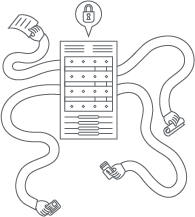Five telltale signs you need to re-evaluate your technology ecosystem
If you’re running a small or medium enterprise in Australia, chances are you are using one of the top three accounting solutions – Xero, MYOB, or QuickBooks. These solutions are incredibly versatile and suit a range of businesses across industries and sizes.
 For many business owners, outgrowing your accounting solution creeps up slowly, over time. It isn’t an ‘urgent fix’ until the pain point (or points) become too great and key stakeholders champion for change. If you have a niggling feeling that your business is on the verge of outgrowing its software, we’ve identified the five (5) most common reasons below and outlined several next steps for you to consider.
For many business owners, outgrowing your accounting solution creeps up slowly, over time. It isn’t an ‘urgent fix’ until the pain point (or points) become too great and key stakeholders champion for change. If you have a niggling feeling that your business is on the verge of outgrowing its software, we’ve identified the five (5) most common reasons below and outlined several next steps for you to consider.
You require consolidation across entities
A huge reason why businesses require a larger accounting solution is because of multi-entity consolidation.
End-of-month reporting across multiple entities can a painful process, and lightweight accounting solutions, although robust, require one entity per file. While you can log into multiple entities using a single login, all data is kept separate.
There are robust reporting solutions that overlay across these out-of-the-box accounting packages, such as Futrli, Spotlight, and Fathom, with the main aim to consolidate entities under their reporting overlay. Without expert assistance, these solutions can be cumbersome to set up and configure and require proficiency in the reporting platform. Many businesses revert to Excel and never properly implement these reporting solutions when they go it alone.
You face an industry-specific challenge
Let’s say your business is in retail or manufacturing and you’re considering expansion into a new eCommerce channel. Or, perhaps, you’re holding stock and want to expand from B2C into a multi-tiered B2B selling model.
These challenges are specific to this industry. Perhaps you’re doing custom manufacturing and want to track job profitability. Stand-alone accounting platforms handle inventory, for example, at a core level, but don’t cater to all the nuances that industries, let alone specific niche players, require.
If you’re either manually handling industry-specific processes or are using an add-on that doesn’t quite cut the mustard, chances are you’ve outgrown your current solution and need to expand your horizons.
Your business is moving into new markets
Moving into a new market doesn’t have to mean a new country (although it can).
Moving to a new location, selling to wholesalers rather than directly to customers, or moving store sales online are all ways of moving into a new space with a business. Standalone accounting solutions can have limitations to the way divisions are configured, multi-currency is handled, multi-language support, and more, which can lead to workarounds for businesses that want to expand quickly.
If you are finding that you have developed a workaround to suit additional tracking requirements, or have adopted an additional application to fix a problem, it could be a sign your business is ready for a larger solution.
Your business model has expanded, and process complexity increased
Have you ever sat back and daydreamed about creating more advanced workflows for processing accounts payable, closing out end of the month, or reminding your team to get the paperwork in on time?
Standalone accounting solutions are fantastic at what they do but leave a few things to be desired when it comes to customisation and building out your own ways of doing things in the system.
And especially as your business model becomes more complex, your business leaders will require customised reports to deliver deep and detailed analysis. It's not uncommon for business owners to request a single dashboard with the most important business metrics, from financials to foot traffic, recurring revenue to website hits, and more, all in one place.
Standalone SaaS (software as a service) solutions lack customisation as a key feature, because it makes these solutions easy to use, and keeps all users following the same process. If your business has a case for customisation, it may be time to re-think.
Your IT architecture has become unwieldy
In this last scenario, businesses have adopted a range of add-ons that require complex integration management to maintain data integrity.
Solutions that generate high volumes of accounts receivable data that passes to Xero via APIs, for example, can turn up with errors and ongoing issues well after your IT team or consultant has pressed the go-live button.
Alternately, you could have adopted too many applications within your ecosystem, that have either become too costly in terms of subscriptions or too difficult to maintain by staff. These could be Customer Relationship Management (CRM) solutions, inventory management, human resources management, or other solutions. You will need to make a decision around whether the extra management is worth the benefit, or if it is time to explore other options.
So what's the solution?
Swapping out your existing accounting software for something more comprehensive is a big task.
There are change management considerations, costs around the selection, implementation, and training of a new solution, and the ongoing increased subscription costs that come with a more robust solution.
1. Review your technology ecosystem to identify gaps.
Our first port of recommendation for customers is to consider where third-party add ons, or apps can solve a particular pain point.
In this case, there is usually a complete solution gap (done by manual processing) or there are multiple solutions that could be combined into a more comprehensive solution.
2. Review your integration points and identify efficiencies
The world of ‘ad hoc automation’, or process automation that can be built on the fly to fix individual problems, has improved greatly in recent years.
Where there used to be only a handful of integration solutions on the market, there are now tens if not hundreds of apps that are dedicated to passing data from one application to another using common (and customised) use cases.
3. Review your accounting solution
Upgrading to an Enterprise Resource Planning (ERP) is not as daunting as it sounds.
There are a wide range of mid-tier solutions on the market that help small and medium-sized businesses streamline their technology ecosystem and improve business processes through a single source of truth. Making the decision to move to an ERP can be time-consuming, and usually involves a full requirements analysis and total cost of ownership assessment. However; the hard work you put in could be rewarded with natively integrated solutions for not just accounting, but also customer relationship management, professional services automation, inventory and warehouse management, and more.
How can RSM help?
At RSM, we can help with all of your accounting solutions. We work with small businesses up to government organisations in successfully selecting, implementing, and maintaining their IT ecosystems.
Please reach out to your local RSM adviser if you want to discuss your current situation and the options available to you in the market.

